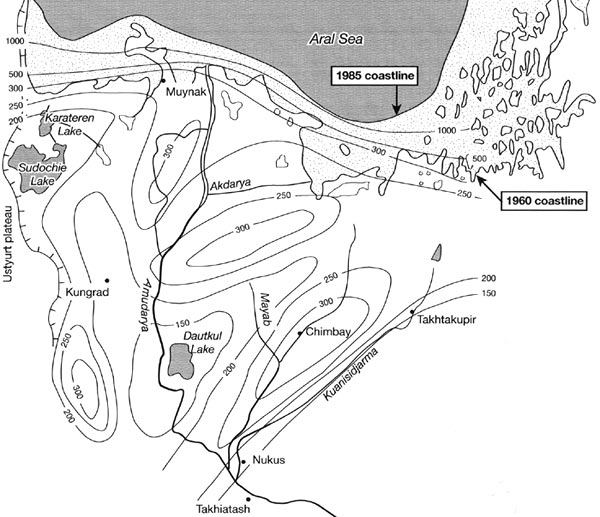Please put an active hyperlink to our site (www.rusnature.info) when you copy the materials from this page
Environmental problems of Northern Eurasia
The Aral Sea
<<< Lake Changes | Environmental Problems Index | Delta Areas
>>>
Climatic Effects
A number of changes in climatic parameters have been noted in the Priaralye and
attributed to the human-induced recession of the Aral Sea since the 1960s (Molosnova et
al., 1987). A general trend towards a more continental climate has been suggested by an
increase in summer and decrease in winter air temperatures at stations near the shore by
1.5-2.5∞C and a decline in mean annual relative humidity of 2-3 per cent, while the
occurrence of drought days has increased by 300 per cent. Shifts in seasonality have also
been recorded. In 1950-59, maximum precipitation fell during February-March and minimum
during September, but in 1970-79 the maximum was observed in April and the minimum in
July. Spring frosts have been recorded later and autumn ones earlier.
Another climatic effect has resulted from the exposure of lacustrine sediments,
particularly on the eastern side of the lake, since 1960. These former lake-bed areas have
become a significant new source of wind-blown material. Marked increases in the annual
frequency of dust storms have been recorded at several stations in the Priaralye over
recent decades, although the rising frequency has not been constant at all stations (Table
22.4a).

Table 22.4 Changes in the annual frequency of dust storms: (a) due to
desiccation of the Aral Sea bed and; (b) due to expansion of irrigation
Major storms first became visible on satellite imagery in 1975 and have increased in
duration as well as frequency since (Micklin, 1988; UNEP, 1992b). In a summary of
estimates of the amount of material deflated annually, Glazovsky (1995b) suggests a range
of 40-150 million tonnes as reasonable for the early 1990s. Sixty per cent of storms carry
dust towards the south-west and 25 per cent travel westward over the Ustyurt plateau
(Micklin, 1988) and Aral dust has been reported as far afield as Belarus and Lithuania to
the north-west, Georgia to the west, and Afghanistan to the south-east (Letolle and
Mainguet, 1993). The material is highly saline, dominated by calcium sulphate but with
significant quantities of sodium chloride, sodium sulphate, magnesium sulphate, and
calcium bicarbonate. Figure 22.5 indicates the pattern of salt deposition to the south of
the Aral Sea coast with deposition rates of 300 kg ha-1 in several zones up to
75 km from the coastline.

Fig. 22.5 Deposition of salts south of the Aral Sea, 1985 (kg ha-1).
After UNEP (1992b)
Sodium chloride and sodium sulphate are particularly toxic to plants, and there is a
widespread belief that this aeolian deposition of salts is adversely affecting both
cropland and natural ecosystems in the Priaralye. Babaev (1996), for example, reports a
steady decline in yields of pasture on the Ustyurt plateau since the 1970s, and Glazovsky
(1995b) suggests that aeolian salt deposition may at least partly explain decreasing
production of silkworm coccoons in Karakalpakiya. By contrast, dust storms at some
stations in irrigated areas have declined in frequency since the 1950s (Table 22.4b).
<<< Lake Changes | Environmental Problems Index | Delta Areas
>>>
Contents of the Aral Sea section:
Other sections of Environmental Problems of Nortern Eurasia:
|
|